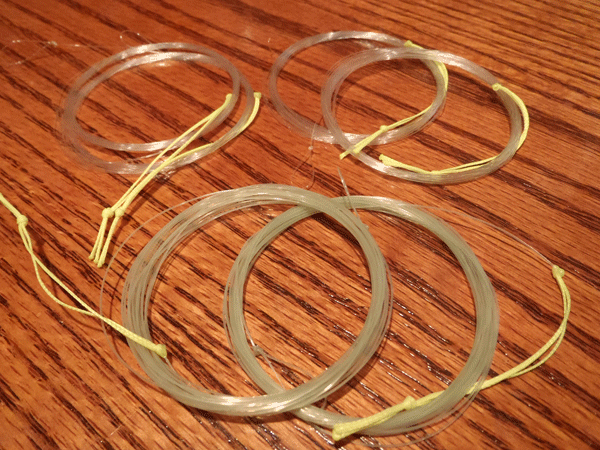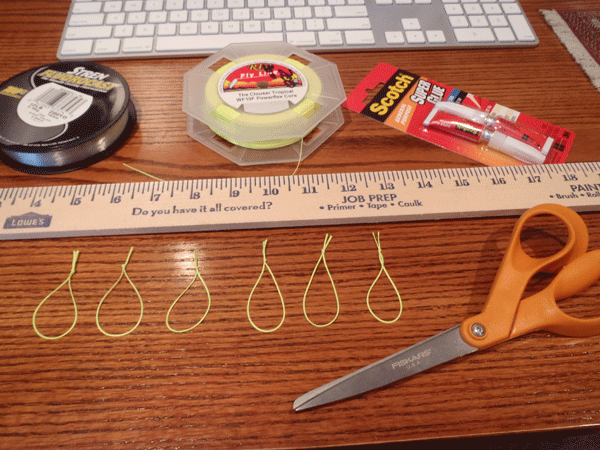Many people talk about high visibility fluorocarbon level lines for Tenkara fly fishing and I’ve recently gotten into them. As a predominantly dry fly fisher, I really don’t “see” (get it) the need for this. And, I think in certain situations, it’s best to have a line you can cast over the fish without scaring them. So I made some experimental level lines using clear fluorocarbon and the braided loop method I recently posted about.
[/caption]
Within 20 minutes I was able to produce 6 level lines with braided loops and using fluorocarbon from both Tenkara USA and Gander Mountain. Not bad. I made two 0.13″ lines in an 11′ length, two 0.11″ lines in a 12′ length, and two o.14″ lines in a 13′ length (for lake fishing).

Tenkara Level Lines - Clear Fluorocarbon (top) and Tenkara USA (bottom)
I have to admit, I’m getting hooked on making my own level lines and playing around with different materials and terminal tackle in combination with different rods. They’re more economical and versatile than furled lines in my opinion and I like the fact that they cast better in the wind (Of course, furled lines still make the most delicate presentation so I’m not totally abandoning them). I’m still developing my perfect line but in the meantime…
Have you ever used a clear Tenkara level line?









I too like using the braided loop, but all I do is tie the level line to it with a knot. At these lengths I don’t think line visiblity makes a difference since I will try to keep all the line suspended and there is only going to be tippet on the water anyhow. At longer lengths when there is going to be some line on the water I think you do have to be careful, and hi-vis line or a sighter comes into play. All in all, though I still enjoy the lightness of a furled leader when throwing drys. Keep up the experimenting, Jason!
Hi Kevin,
Good points! I still like furled lines for throwing dries when it’s not windy or when I need a more delicate presentation but I am liking level lines more and more since I’ve been practicing different casting techniques that make the fly land first and keep nearly all of the line out of the water for a better dead drift.
I’ve been practicing a casting style like Tenkara no Oni’s and to me, level lines work better for this approach. If you want to cast more like a Western approach, then the furled lines seem to work better.
Does this match your experience?
Jason, what line weight/class of fluorocarbon are you using to make your clear level lines with? Thanks, John
Hi John, I don’t use clear lines anymore but when I did, here is what I used: https://www.tenkaratalk.com/2011/06/tenkara-level-line-experiments/
Jason, your experience seems similar mine. Fluorocarbon lines (both level and tapered) are more versatile, especially in wind and with wet flys and nymphs, and I think most tenkara anglers will find themselves using them more as they advance, even for dry flies.
My experiments with furled leaders (length, loops, and materials) has been fun and by increasing their density and using a less linear taper, makes them more versatile than the standard nylon. Equipped with a sufficient tippet, they provide a grace for dry fly fishing that I have not been able to match with even delicately tapered fluorocarbon lines, though it’s close. (Chris Stewarts come to mind as very delicate indeed.)
The crisp, compact, yet relaxed cast of Tenkara no Oni’s is outstanding. We could all benefit from emulating his cast… and demeanor.
Hi Kevin,
Thanks for the reinforcement. I’m also experimenting with using tippet rings rather than using a perfection loop to connect the tippet. Will post more on that later.
Hi Jason,
The first thing I did when I got my 12 foot Iwana rod was to
Zapa-Gap glue a braided loop on to the end of the Lillian. With
perfect loops tied into each end of your line, you can just
connect the line to the rod or add tippet to the line with the
loop-to-loop connection and, you get a much more straight line
connection and better casting accuracy in my view than you can
get with the off-center standard Tenkara mounting method. The
only drawback that I can see to using the loop-to-loop method is
the necessity of having to pull the whole line through one of
the loops to make the loop-to-loop connection. But that is not a
big deal with lines as short as the lengths that are commonly
used in Tenkara fishing. On the tippet end, a surgeon’s loop
knot is a quick, strong and easy to tie knot, especially if it
is windy, to tie in tippet for your loop-to-loop line/tippet
juncture. Please try using the loop-to-loop system and see if
you do not think it is an improvement to the Tenkara angling
system…Karl.
Hi Karl,
Thanks for posting this idea. I don’t like the loop to loop connection exactly for the reason you point out–having to run the line though the loop to remove it. I like the way you can just pull the tag end of a girth hitch to remove the line so that’s why I prefer this connection.
I haven’t really noticed a difference in the way it casts. I see your point about the loop-to-loop connection being straighter but I can’t really tell a difference in casting accuracy between the two. Do you think there’s a significant difference?
Jason, considering that the difference is probably only a fraction of a degree because of the length of the line, no I don’t think the difference is probably very noticeable, if it is noticeable at all to most people. The off center mount and the introduction of what I considered to be an unnecessary third element, the girth hitch, just seems unnecessary to me. You have to stretch the line anyway to get the coil set out of the line, so the stretching can be done at the same time you are pulling the line through the loop.
Also, I was concerned about the possibility of brush getting entangled up in the girth hitch at some point. I fish a lot of very brushy little creeks around here, and Murphy is very alive and quite well, as in what can go wrong will go wrong, eventually. As a matter of fact I have developed a healthy case of fishing envy from seeing the great photographs you have put up on the board about fishing in Colorado and RMNP. It is so much more open there than most of the freestone streams we have around here to fish, which are usually located down in the bottom of very steep and narrow little canyons, with lots of buck brush, willows, wild roses and manzanita bushes.
In my western fly fishing, I constantly use the loop-to-loop method because I am constantly changing back and forth between short small stream and fairly long lake leaders, and also for using different sinking and floating leaders, depending on where I am fishing. Changing the loop-to-loop leader to line connection has become habitual and very subconscious for me, so I am comfortable sticking with what I am used to doing, just as I am sure you are comfortable with using the girth hitch, Tenkara method you are used to using. I don’t think there is any “right” way of doing it; we are both after the same results – hooking and playing trout.
I used to tie my damselfly nymphs with mono-eyes that I made up myself with the same melting technique that you used above, and I have had the melted mono-eye ball break off my flies because of wear, age and rock abrasion. I have also had super glue fail for the very same reasons, so it is probably 6 of one and half-a-dozen of the other as to which is the most durable. Sometimes, stuff just happens whether we like it or not.
Hi Karl,
Yep, you’re right–different situations require different techniques and to each their own. I know what you mean about the brushy streams. I grew up in New York state and we had plenty of those. It was a lot different after I moved to Colorado where I suddenly didn’t have to worry about overhanging trees as much. Wouldn’t it be great to have an adjustable tenkara line? I’ve been trying to design one but just can’t see to make the knots work. If I ever do, I will certainly post about it. I think a lot of tenkara anglers would love to be able to adjust the length of their tenkara lines without having to remove sections of line with a knot or loop-to-loop connection.
Since hi-vis fluorocarbon is not easy to find in my area(Romania),I’m thinking to use Stren fc lines(0.35mm or 0.38mm) + line sighters. Are they suitable for Tenkara?